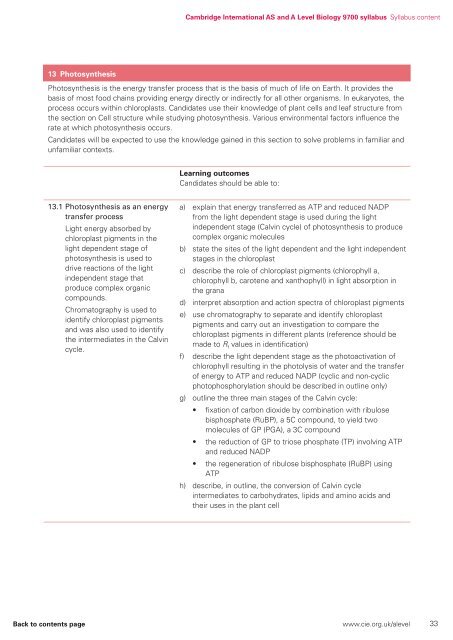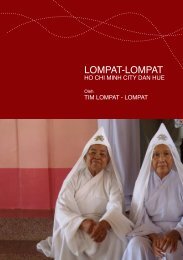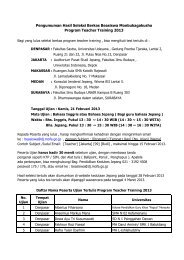9700_y16_sy
9700_y16_sy
9700_y16_sy
You also want an ePaper? Increase the reach of your titles
YUMPU automatically turns print PDFs into web optimized ePapers that Google loves.
Cambridge International AS and A Level Biology <strong>9700</strong> <strong>sy</strong>llabus Syllabus content<br />
13 Photo<strong>sy</strong>nthesis<br />
Photo<strong>sy</strong>nthesis is the energy transfer process that is the basis of much of life on Earth. It provides the<br />
basis of most food chains providing energy directly or indirectly for all other organisms. In eukaryotes, the<br />
process occurs within chloroplasts. Candidates use their knowledge of plant cells and leaf structure from<br />
the section on Cell structure while studying photo<strong>sy</strong>nthesis. Various environmental factors influence the<br />
rate at which photo<strong>sy</strong>nthesis occurs.<br />
Candidates will be expected to use the knowledge gained in this section to solve problems in familiar and<br />
unfamiliar contexts.<br />
Learning outcomes<br />
Candidates should be able to:<br />
13.1 Photo<strong>sy</strong>nthesis as an energy<br />
transfer process<br />
Light energy absorbed by<br />
chloroplast pigments in the<br />
light dependent stage of<br />
photo<strong>sy</strong>nthesis is used to<br />
drive reactions of the light<br />
independent stage that<br />
produce complex organic<br />
compounds.<br />
Chromatography is used to<br />
identify chloroplast pigments<br />
and was also used to identify<br />
the intermediates in the Calvin<br />
cycle.<br />
a) explain that energy transferred as ATP and reduced NADP<br />
from the light dependent stage is used during the light<br />
independent stage (Calvin cycle) of photo<strong>sy</strong>nthesis to produce<br />
complex organic molecules<br />
b) state the sites of the light dependent and the light independent<br />
stages in the chloroplast<br />
c) describe the role of chloroplast pigments (chlorophyll a,<br />
chlorophyll b, carotene and xanthophyll) in light absorption in<br />
the grana<br />
d) interpret absorption and action spectra of chloroplast pigments<br />
e) use chromatography to separate and identify chloroplast<br />
pigments and carry out an investigation to compare the<br />
chloroplast pigments in different plants (reference should be<br />
made to R f<br />
values in identification)<br />
f) describe the light dependent stage as the photoactivation of<br />
chlorophyll resulting in the photolysis of water and the transfer<br />
of energy to ATP and reduced NADP (cyclic and non-cyclic<br />
photophosphorylation should be described in outline only)<br />
g) outline the three main stages of the Calvin cycle:<br />
• fixation of carbon dioxide by combination with ribulose<br />
bisphosphate (RuBP), a 5C compound, to yield two<br />
molecules of GP (PGA), a 3C compound<br />
• the reduction of GP to triose phosphate (TP) involving ATP<br />
and reduced NADP<br />
• the regeneration of ribulose bisphosphate (RuBP) using<br />
ATP<br />
h) describe, in outline, the conversion of Calvin cycle<br />
intermediates to carbohydrates, lipids and amino acids and<br />
their uses in the plant cell<br />
Back to contents page<br />
www.cie.org.uk/alevel<br />
33





